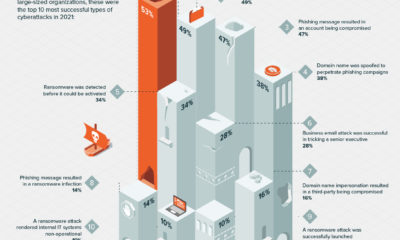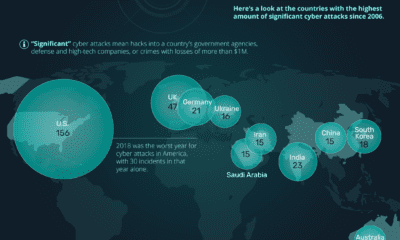Technology
How to Stop Your Home From Being Hacked

How to Stop Your Home From Being Hacked
Billions of new objects are being connected to the internet of things (IoT), and it’s going to change your life.
However, if you are not careful, this change may not be in the positive way that is expected.
As more home devices get connected to the internet, new doors get opened for hackers to potentially access your personal information. Any hacking of this data could have dire consequences to your personal life, career, or financial security.
Today’s infographic from RefiGuide gives context around IoT hacking, including the range of security concerns created by new IoT devices and suggestions on how you can protect yourself.
IoT Hacking Isn’t New
Did you know that former Vice President Dick Cheney had a Wi-Fi enabled pacemaker? His cardiologist disabled this feature in 2007 to ensure that hackers couldn’t control his heartbeat. While this seems like the plot from the TV series Homeland (it was), that doesn’t make it any less possible.
Internet security experts have been warning for years about the dangers of a more connected world. To date, we’ve seen the following examples of IoT hacks:
- Jeep recalled 1.4 million vehicles after it was proven they could be hacked remotely
- Same goes for a Ford Escape, using a physical connection and laptop
- Over 100k IoT devices were used to block traffic to sites such as Twitter and Netflix in a DDoS attack
- Samsung “smart fridges” were found to leave Gmail login credentials vulnerable to hackers
Despite thousands of new IoT devices hitting the market, the fact is that many lack sufficient encryption features. This makes them particularly vulnerable.
Further, connected devices provide multiple entrances for would-be hackers: the device, connected devices, data centers, and communication channels are all possible access points.
How to Protect Yourself
Until manufacturers are able to guarantee that basic cybersecurity measures are in place for new IoT devices, there are a few ways you can protect yourself.
First, make strong passwords for your router and connected devices, and consider disabling them when you are away from home for extended periods of time. Don’t connect devices that you don’t need – consider holding off on your Wi-Fi connected “smart fridge” until it is something you truly need.
Next, create segmented networks at home for your IoT devices, PC and mobile, and guests. Give each of them different tiers of access, such that someone hacking the IoT network will not be able to tap into your personal data.
Lastly, keep your router firmware up-to-date. This is the programming it uses to function, and regularly updating firmware (either automatically or manually) means that it will be less vulnerable to hacks.
Technology
All of the Grants Given by the U.S. CHIPS Act
Intel, TSMC, and more have received billions in subsidies from the U.S. CHIPS Act in 2024.

All of the Grants Given by the U.S. CHIPS Act
This was originally posted on our Voronoi app. Download the app for free on iOS or Android and discover incredible data-driven charts from a variety of trusted sources.
This visualization shows which companies are receiving grants from the U.S. CHIPS Act, as of April 25, 2024. The CHIPS Act is a federal statute signed into law by President Joe Biden that authorizes $280 billion in new funding to boost domestic research and manufacturing of semiconductors.
The grant amounts visualized in this graphic are intended to accelerate the production of semiconductor fabrication plants (fabs) across the United States.
Data and Company Highlights
The figures we used to create this graphic were collected from a variety of public news sources. The Semiconductor Industry Association (SIA) also maintains a tracker for CHIPS Act recipients, though at the time of writing it does not have the latest details for Micron.
| Company | Federal Grant Amount | Anticipated Investment From Company |
|---|---|---|
| 🇺🇸 Intel | $8,500,000,000 | $100,000,000,000 |
| 🇹🇼 TSMC | $6,600,000,000 | $65,000,000,000 |
| 🇰🇷 Samsung | $6,400,000,000 | $45,000,000,000 |
| 🇺🇸 Micron | $6,100,000,000 | $50,000,000,000 |
| 🇺🇸 GlobalFoundries | $1,500,000,000 | $12,000,000,000 |
| 🇺🇸 Microchip | $162,000,000 | N/A |
| 🇬🇧 BAE Systems | $35,000,000 | N/A |
BAE Systems was not included in the graphic due to size limitations
Intel’s Massive Plans
Intel is receiving the largest share of the pie, with $8.5 billion in grants (plus an additional $11 billion in government loans). This grant accounts for 22% of the CHIPS Act’s total subsidies for chip production.
From Intel’s side, the company is expected to invest $100 billion to construct new fabs in Arizona and Ohio, while modernizing and/or expanding existing fabs in Oregon and New Mexico. Intel could also claim another $25 billion in credits through the U.S. Treasury Department’s Investment Tax Credit.
TSMC Expands its U.S. Presence
TSMC, the world’s largest semiconductor foundry company, is receiving a hefty $6.6 billion to construct a new chip plant with three fabs in Arizona. The Taiwanese chipmaker is expected to invest $65 billion into the project.
The plant’s first fab will be up and running in the first half of 2025, leveraging 4 nm (nanometer) technology. According to TrendForce, the other fabs will produce chips on more advanced 3 nm and 2 nm processes.
The Latest Grant Goes to Micron
Micron, the only U.S.-based manufacturer of memory chips, is set to receive $6.1 billion in grants to support its plans of investing $50 billion through 2030. This investment will be used to construct new fabs in Idaho and New York.
-

 Energy1 week ago
Energy1 week agoThe World’s Biggest Nuclear Energy Producers
-

 Money2 weeks ago
Money2 weeks agoWhich States Have the Highest Minimum Wage in America?
-

 Technology2 weeks ago
Technology2 weeks agoRanked: Semiconductor Companies by Industry Revenue Share
-

 Markets2 weeks ago
Markets2 weeks agoRanked: The World’s Top Flight Routes, by Revenue
-

 Countries2 weeks ago
Countries2 weeks agoPopulation Projections: The World’s 6 Largest Countries in 2075
-

 Markets2 weeks ago
Markets2 weeks agoThe Top 10 States by Real GDP Growth in 2023
-

 Demographics2 weeks ago
Demographics2 weeks agoThe Smallest Gender Wage Gaps in OECD Countries
-

 United States2 weeks ago
United States2 weeks agoWhere U.S. Inflation Hit the Hardest in March 2024














